Starting a new website is exciting, and like many, you probably dream of seeing it rank on the first page of Google.
But here’s the thing: achieving that top spot on the first page of Google doesn’t happen by chance. It requires strategic planning and careful execution of SEO techniques right from the very beginning.
In this post, we’ll discuss how you can do SEO for a new website.
We’ll provide easy-to-follow instructions to help you optimize a new website, from conducting keyword research to optimizing your website’s structure and content.
So, without any further ado, let’s get started.

Table Of Contents
- How to Do SEO for a New Website
- Choose a Domain Name
- Choose a Reliable Hosting Provider
- Create a Logical Site Structure
- Set up Google Search Console
- Ensure Your Site is Mobile Friendly
- Conduct Keyword Research
- Create Content Optimized for SEO
- Optimize for On-Page SEO
- Enhance User Experience
- Promote Your Website
- Track Your Performance
- Conclusion
How to Do SEO for a New Website
Let us discuss the steps to optimize a new website for SEO.
1 Choose a Domain Name
Choosing the right domain name is the first step to optimizing a new website for SEO.

Opt for a domain name that reflects the content and purpose of your website. Ideally, it should include keywords relevant to your niche or industry.
We recommend using namelix.com to generate domain name ideas.
Start by entering keywords related to your business. For example, if you’re starting a BBQ blog, try words like barbecue and flame. Click Generate to continue.

Choose a name style — Auto is a good starting point. Then, select how creative you want the results to be. The High option gives more variety, but if you want a balanced mix, go with Medium. Click Next.

You can add a brief business description here, or leave it blank and hit Generate.
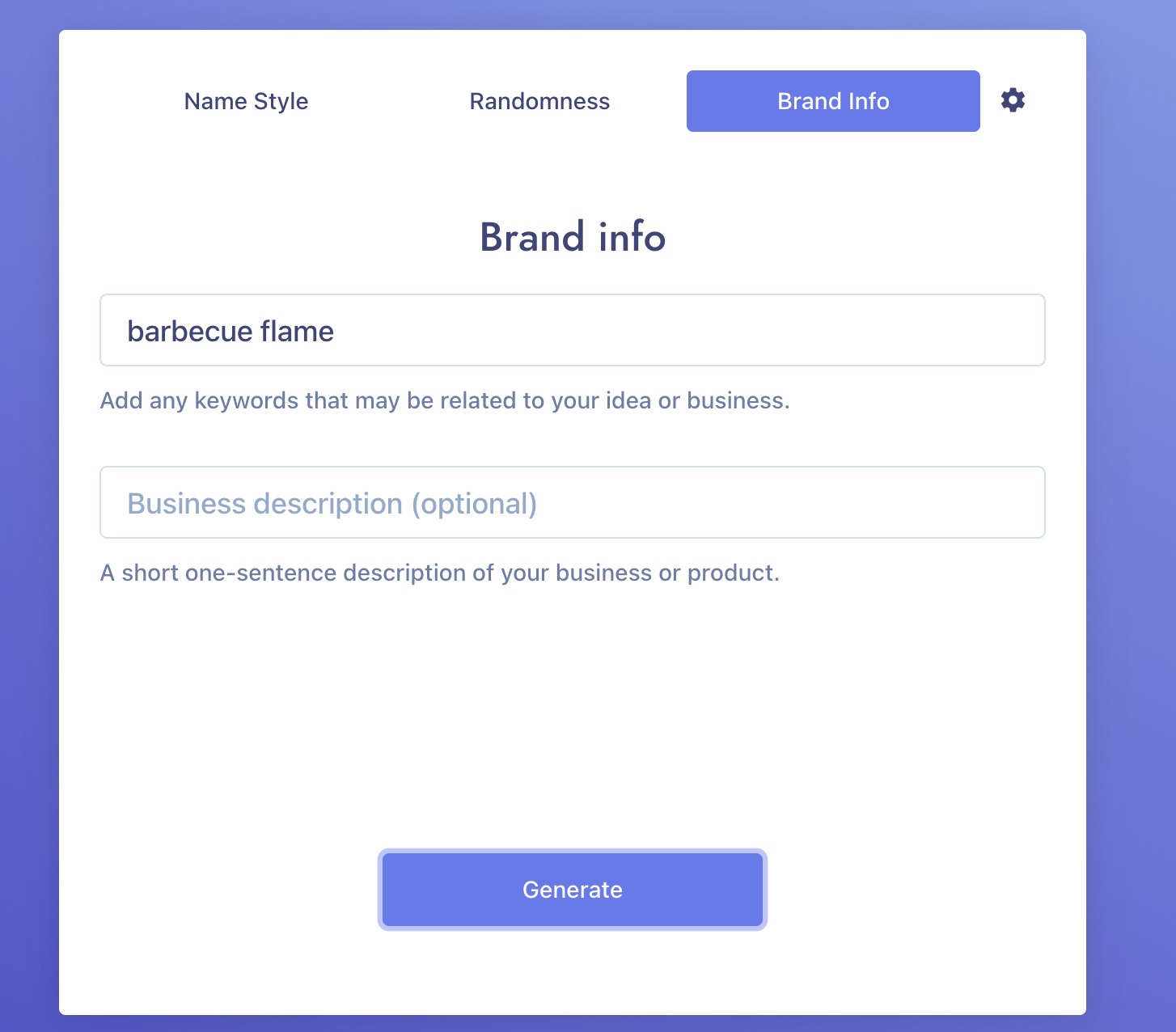
Namelix will now suggest domain names. The green checkbox indicates that the .com version is available. Browse through the list and pick a name you like.

Keep your domain name concise and to the point. Shorter domain names are easier to type, remember, and share. Aim for a domain name no more than 15-20 characters long, excluding the domain extension (.com, .net, .org, etc.).
While .com is the most commonly used domain extension, many other options are available, including .net, .org, .co, and country-specific extensions like .uk or .au.
When choosing a domain extension, consider your target audience and the nature of your website. If you’re targeting a global audience, .com is usually the best choice.
However, if your website is intended for a specific geographic region or industry, a country code or industry-specific extension might be more appropriate.
2 Choose a Reliable Hosting Provider
Your web hosting provider plays an important role in improving SEO for your website. It affects performance, uptime, speed, and security — all of which impact search engine rankings and user experience.
Before making a decision, research each provider’s reputation. Read independent reviews, user testimonials, and performance comparisons to evaluate:
- Uptime reliability: Aim for providers with at least 99.9% uptime.
- Page load speed: Faster websites tend to rank higher in search results.
- Customer support: Responsive, helpful support can save you hours of troubleshooting.
- Ease of use: Especially important if you’re new to website management.
One.com is a reputable hosting provider known for its user-friendly interface and affordable hosting plans.
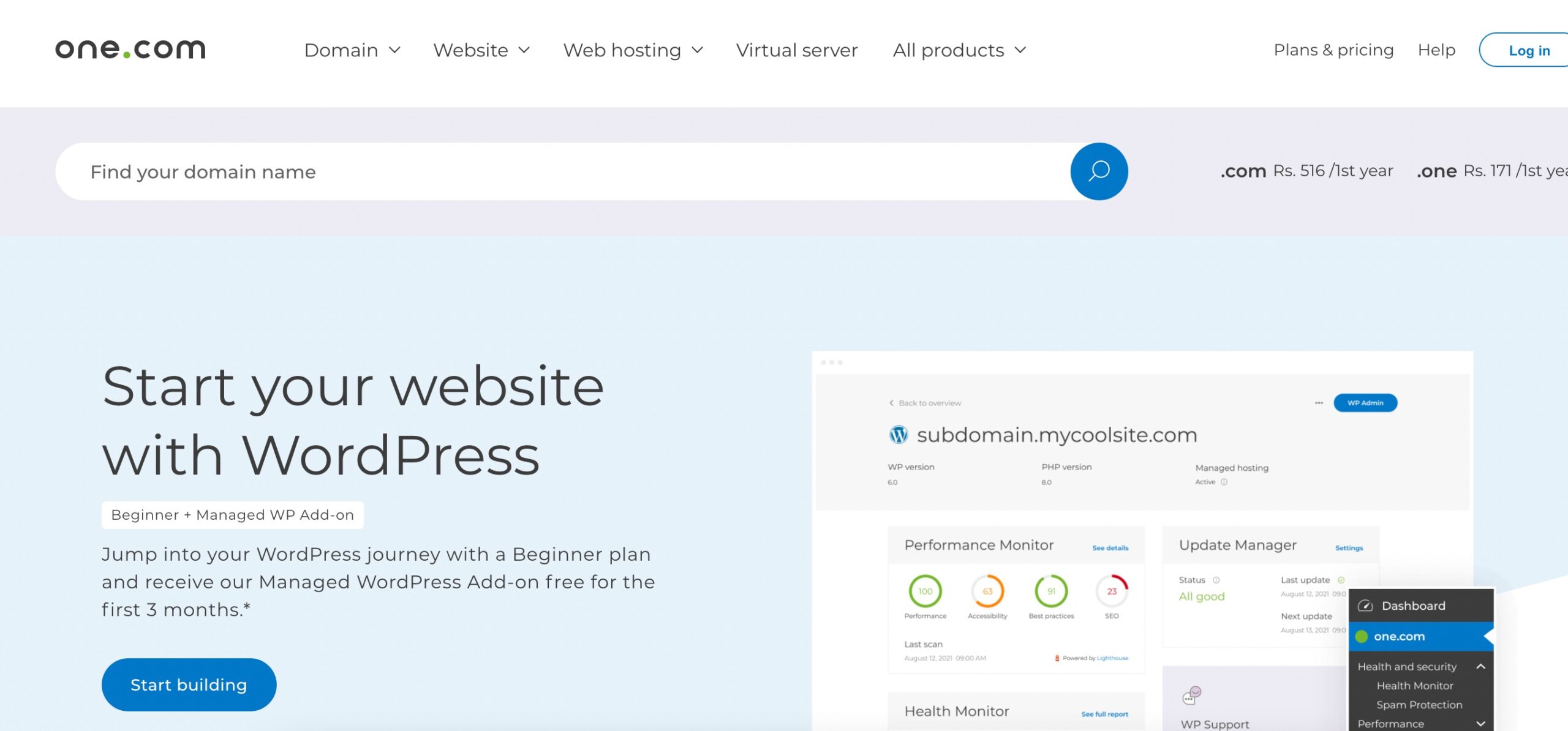
They offer various services, including web hosting, auto-updates, and powerful security. One.com provides reliable uptime, fast page loading speeds, and scalable hosting solutions to accommodate websites of all sizes.
Once your hosting is set up, the next step is choosing a content management system (CMS). While options like Joomla and Drupal exist, we recommend WordPress for its simplicity, wide support, and no-code-friendly setup.
If you’re using One.com, Rank Math SEO — one of the most powerful SEO plugins — will be automatically installed. If it’s not available in your plugin list, you can easily install and activate it.
Refer to our dedicated tutorial on setting up Rank Math on your site.
3 Create a Logical Site Structure
A well-organized site structure helps both users and search engines navigate your website with ease. It improves crawlability, distributes link equity efficiently, and enhances the overall user experience.
Start by mapping out your website’s main categories and subcategories. Use a top-down hierarchy, placing broad topics at the top level and nesting more specific pages beneath them.
Next, ensure that your URLs are clear and descriptive, incorporating relevant keywords to indicate the content of each page. For example, a URL like www.example.com/mens-fashion/shirts communicates that the page contains information about men’s shirts.
Refer to our dedicated tutorial on website structure to create a well-structured website.
Use internal links to connect related pages across your website. This not only helps visitors navigate your site but also distributes SEO value (link equity) and assists search engines in discovering your content. For instance, a blog post on “How to Style Men’s Shirts” can link to the men’s shirts category page.
Rank Math performs real-time checks on your post and notifies you if no internal links are present. This allows you to easily add an internal link, enhancing the on-page SEO of your post or page.

Additionally, creating an XML sitemap listing all the pages on your website and submitting it to search engines ensures that all pages are indexed and crawled effectively.
4 Set up Google Search Console
Visit the Google Search Console website and sign in with your Google account. If you don’t have a Google account, you’ll need to create one.
Once logged in, click on the Add Property button and enter the URL of your website. Make sure to enter the full URL, including the “http://” or “https://” prefix, and select the appropriate version (www or non-www).
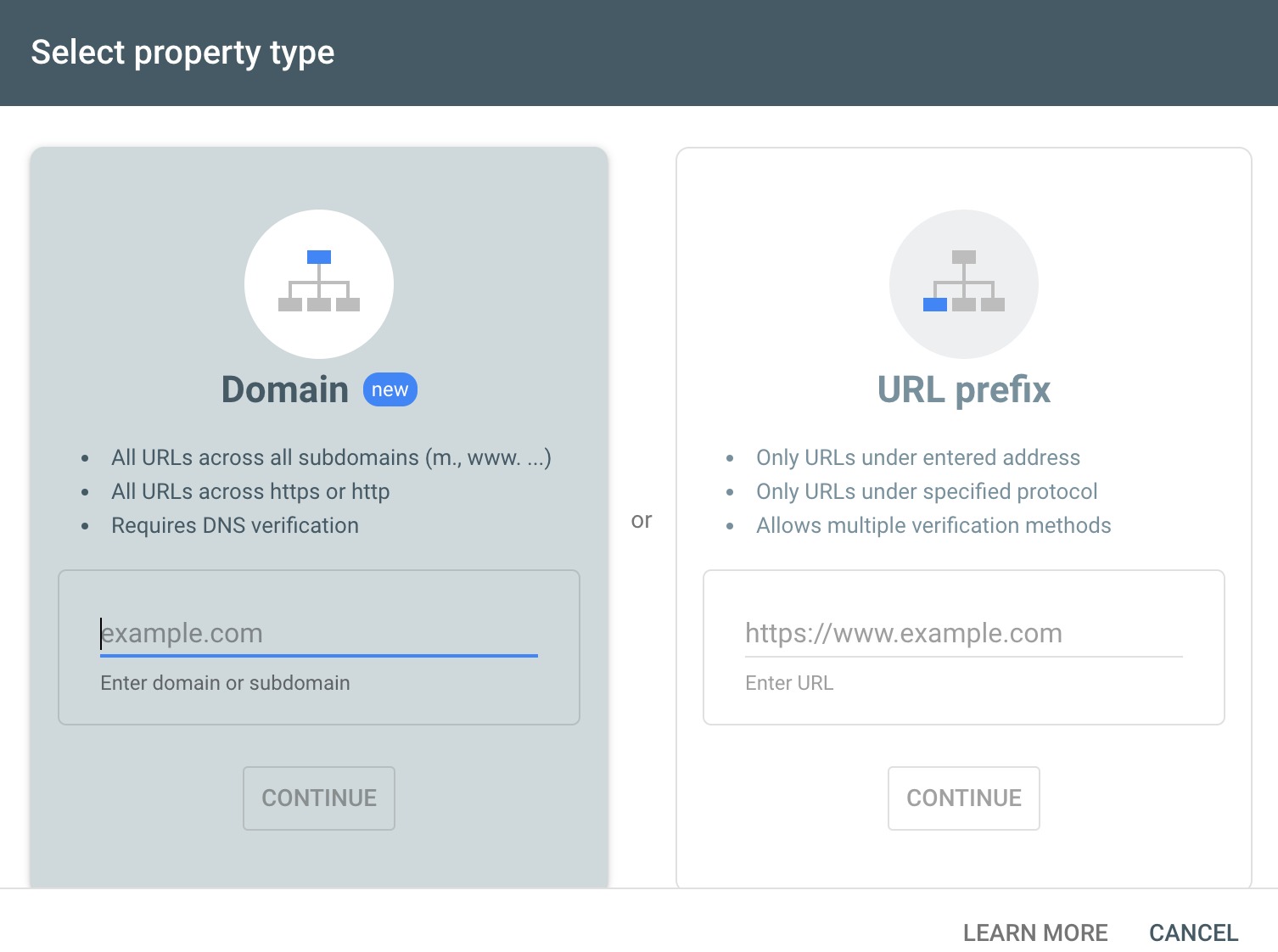
Google Search Console requires you to verify the website’s ownership before you can access its data and features.
Several verification methods are available, including HTML file upload, HTML tag insertion, domain name provider, Google Analytics tracking code, and Google Tag Manager.
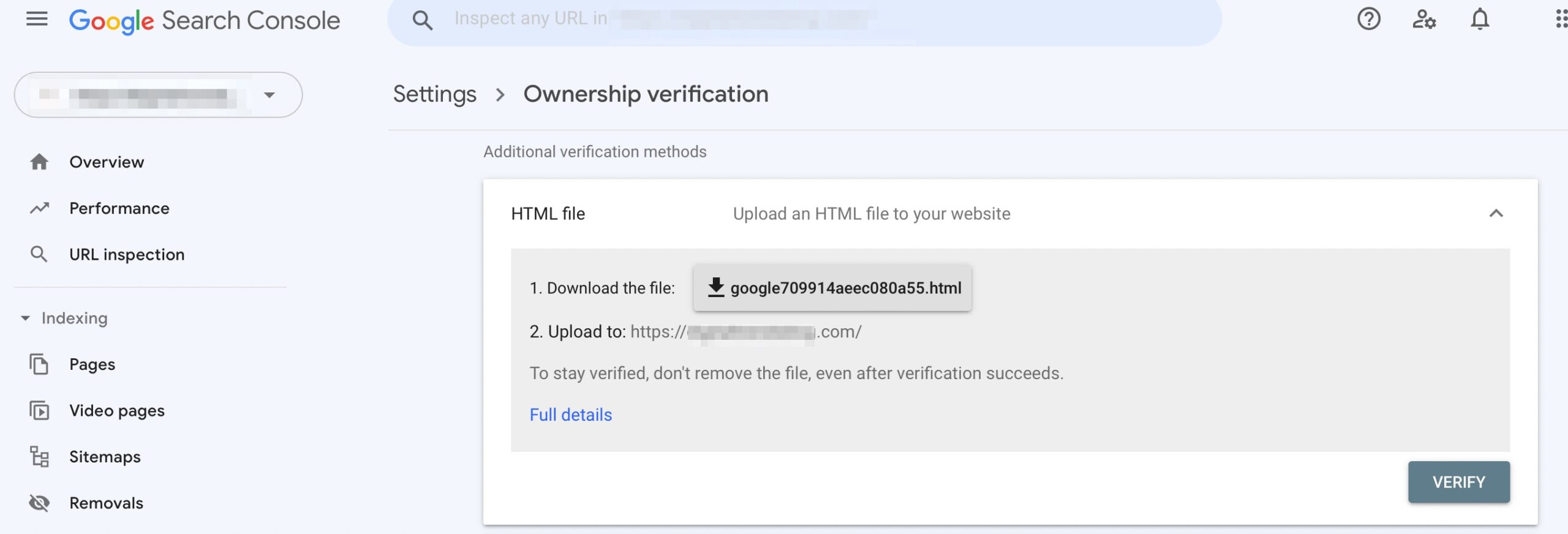
Once you’ve implemented the chosen verification method, Google will check the verification status, and once verified, you’ll gain access to your website’s data and tools within Google Search Console.
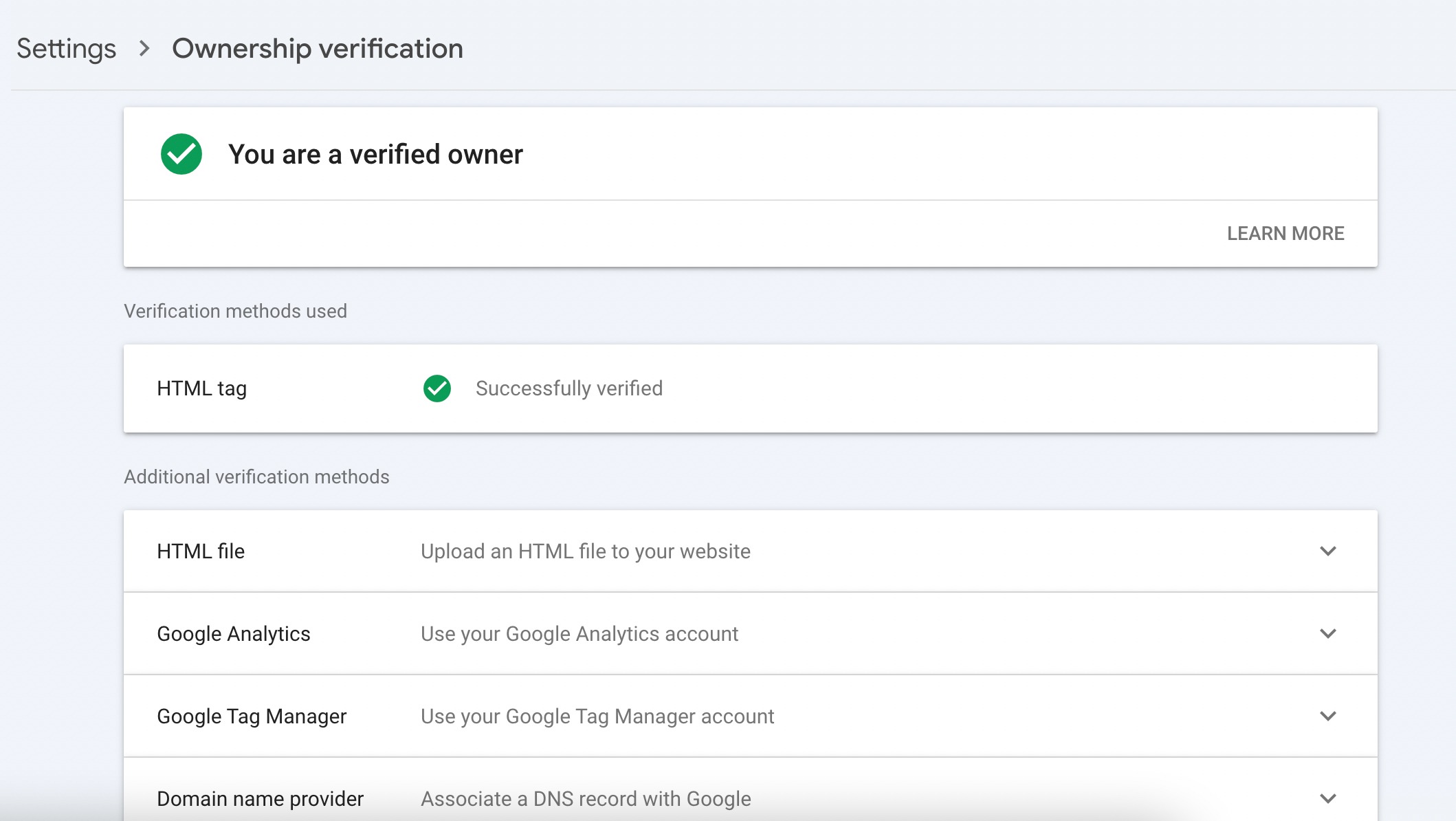
Rank Math includes a feature that automatically creates and verifies a property for your website in Google Search Console.
Rank Math simplifies gathering and displaying valuable insights directly within your WordPress dashboard. To help Rank Math access data from Google Search Console, you must connect your Google account with Rank Math.
5 Ensure Your Site is Mobile-Friendly
While doing SEO for a new website, ensure your site is mobile-friendly.
With increasing audiences accessing the internet via mobile devices, search engines prioritize mobile-friendly websites in their rankings.
To optimize a new website for mobile-friendliness, focus on responsive design principles. These principles ensure your website displays correctly and functions effortlessly across various screen sizes and devices.
This includes using flexible layouts, scalable images, and adjustable text sizes to accommodate smaller screens without sacrificing usability or readability.
Additionally, prioritize fast page loading times on mobile devices by minimizing file sizes, using browser caching, and optimizing server response times. You can install the WP Rocket plugin to boost your loading time.
You can use PageSpeed Insights to check where your website needs to improve and test your site’s mobile-friendliness with the help of Bing’s Mobile Friendliness Test Tool.
6 Conduct Keyword Research
Keyword research is the foundation of SEO for a new website, helping you discover the exact terms your target audience is searching for so you can create content that ranks and drives traffic.
If your website is new, avoid targeting highly competitive keywords dominated by government or high-authority sites. You won’t rank.
Two Phases of Keyword Research:
- Early Phase: Focus on keywords with decent search volume and low competition — ideal for new websites.
- Growth Phase: Once your site gains authority and search engines understand your niche, target more competitive keywords to build topical authority, becoming a trusted expert in your field.
Start by listing keywords related to your niche. You don’t have to brainstorm from scratch. You can use AI for your research.
In fact, 78% of AI users rely on 1-3 AI tools, and over half of them are satisfied with the outcomes.
Tools like RankBot can generate a topical map for your industry (e.g., BBQ), suggesting blog categories to target.
For instance, if you’re interested in BBQ techniques, you can ask RankBot for long-tail keywords under that category. Long-tail keywords are more specific (usually 3+ words) and easier to rank for, especially conversational queries.
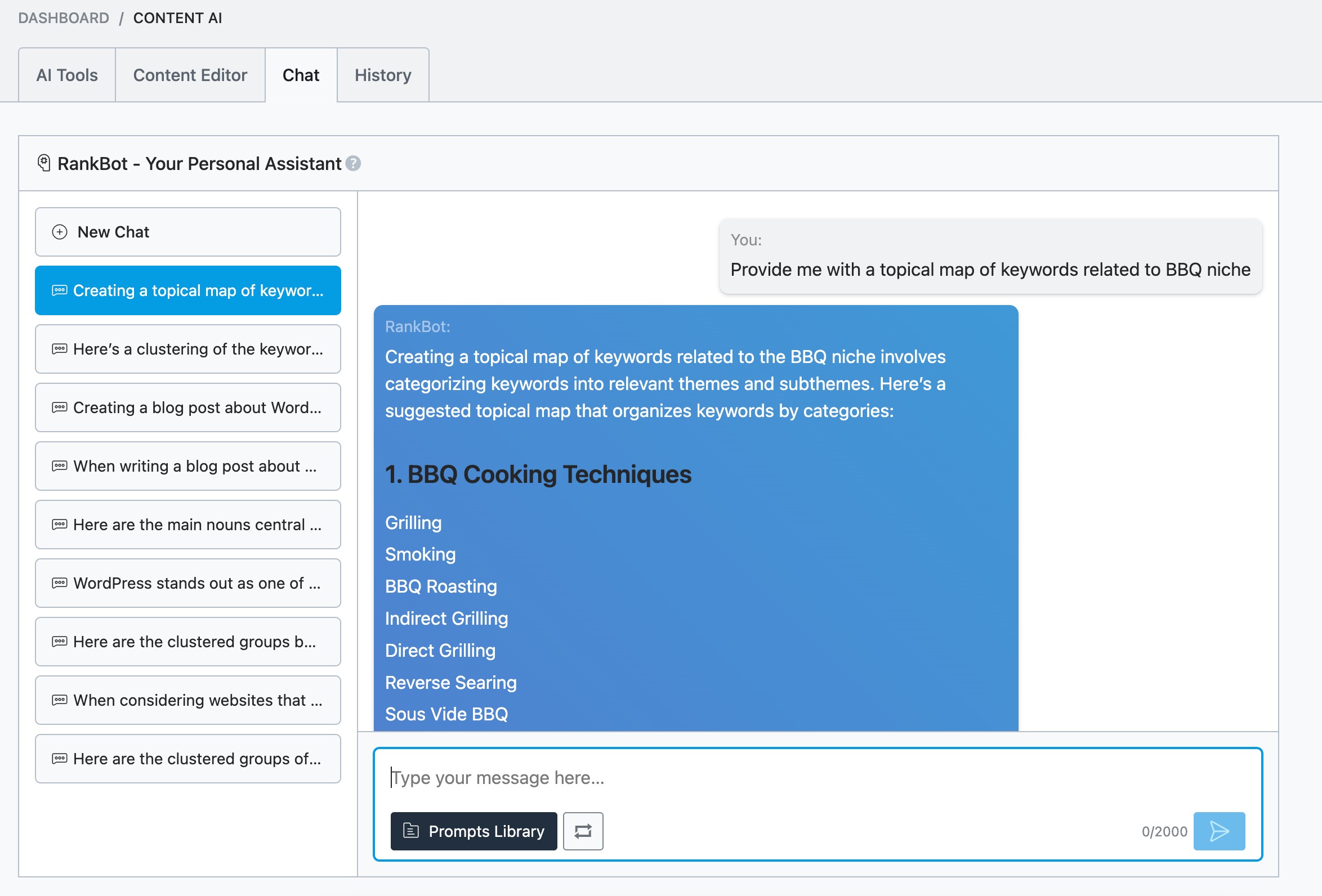
Once you’ve gathered a list, use Google Keyword Planner to check if they have search volume. Use tools like Ubersuggest to analyze the top 10 results for each keyword.
If the top results are mostly high-authority sites (DA 50+), save that keyword for later.
If you see lower-authority sites (DA below 30) ranking, it’s a good keyword to target.
Refer to our dedicated tutorial on keyword research to perform keyword research and improve SEO for your website.
Once you have compiled a list of target keywords, prioritize them based on relevance, search volume, and competition, and integrate them strategically into your website’s content, including titles, headings, meta descriptions, and the content’s body.
Don’t forget to continuously monitor and update your keyword strategy based on performance metrics and changes in search trends to ensure your website remains optimized for maximum visibility and organic traffic.
7 Create Content Optimized for SEO
Creating content optimized for SEO is necessary for any successful strategy to boost your new website’s visibility in search engine results.
Analyze Search Intent
Before creating content, you must understand your target keywords’ search intent. Analyze the types of queries your audiences enter into search engines and determine whether they’re looking for informational, navigational, transactional, or commercial-intent content.
Create content matching the search intent by providing the most relevant and valuable information that satisfies the user’s query.
For instance, if the search intent is informational, create comprehensive guides, tutorials, or how-to articles that address common questions or problems within your niche.
Rank Math PRO helps you optimize content by revealing the intent behind your primary keyword. Click the Show Intent label to check its intent or move another keyword to the first position for analysis. This feature ensures your content stays relevant to search intent without guesswork.
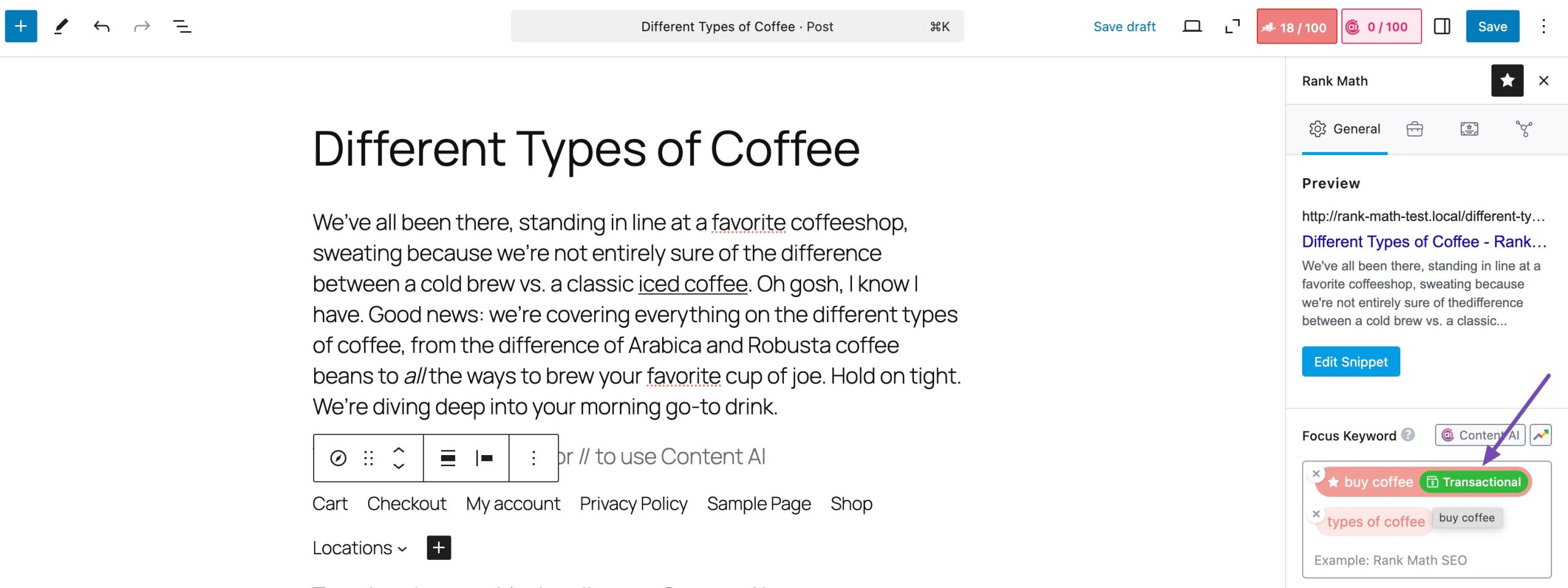
Make It Unique and Easy to Read
Once you’ve identified the search intent, you can use Rank Math’s Blog Post Wizard AI tool to create a well-optimized blog post for you.
If you already have a topic, you can skip the first step (idea generation). In the second step, enter your topic and paste your research points—separated by commas—into the input field. If you’re unsure what to include, you can click the Generate with AI prompt to get suggestions.
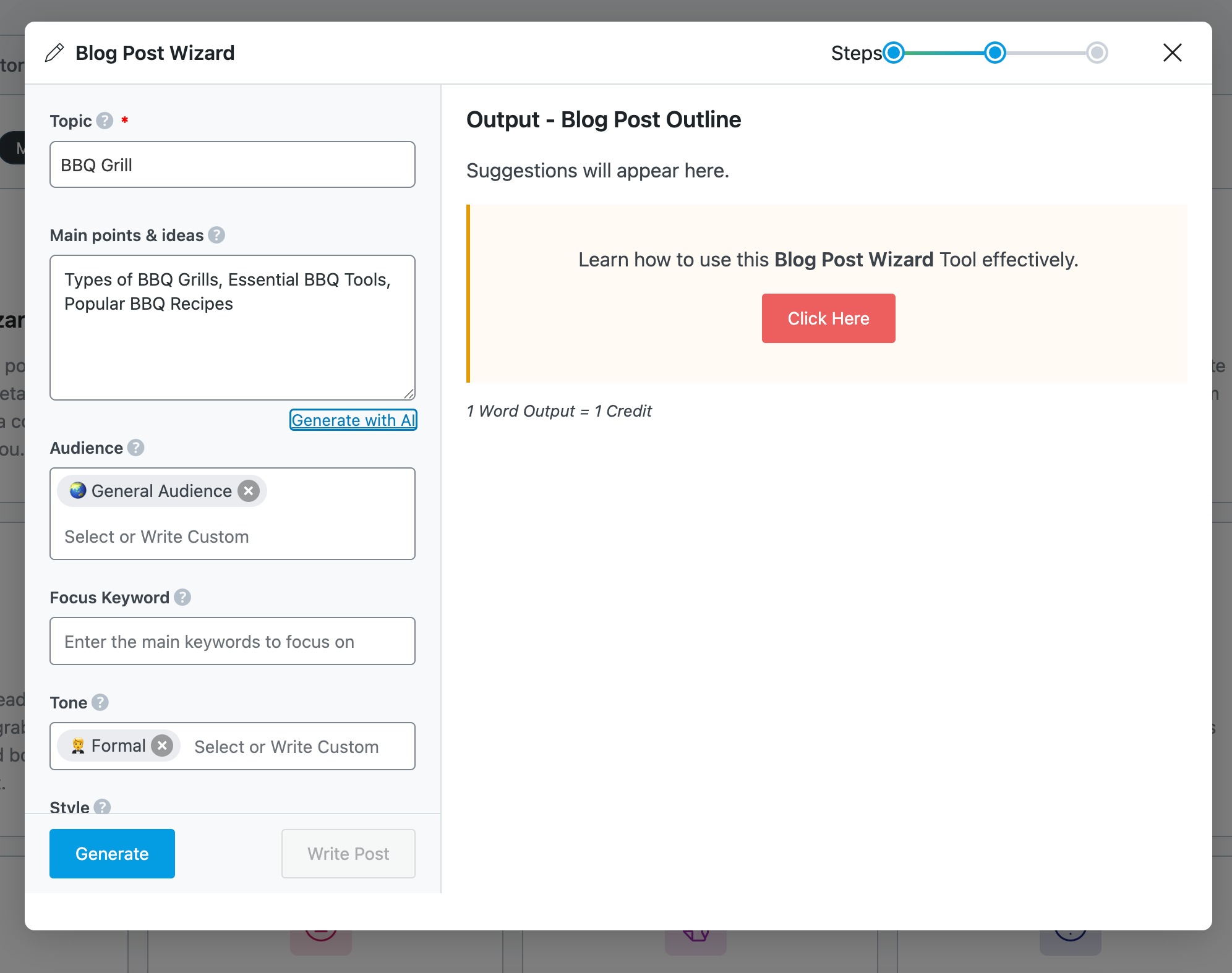
Select your target audience and enter your focus keyword—usually the same as your topic. You can also add secondary keywords for optimization.
Then, choose a tone that suits your niche; for a BBQ topic, an informal, friendly, and casual tone works best. For the format, a listicle style is ideal for topics like “best woods for smoking meats.”
Select your preferred language (e.g., US English), then click Generate.
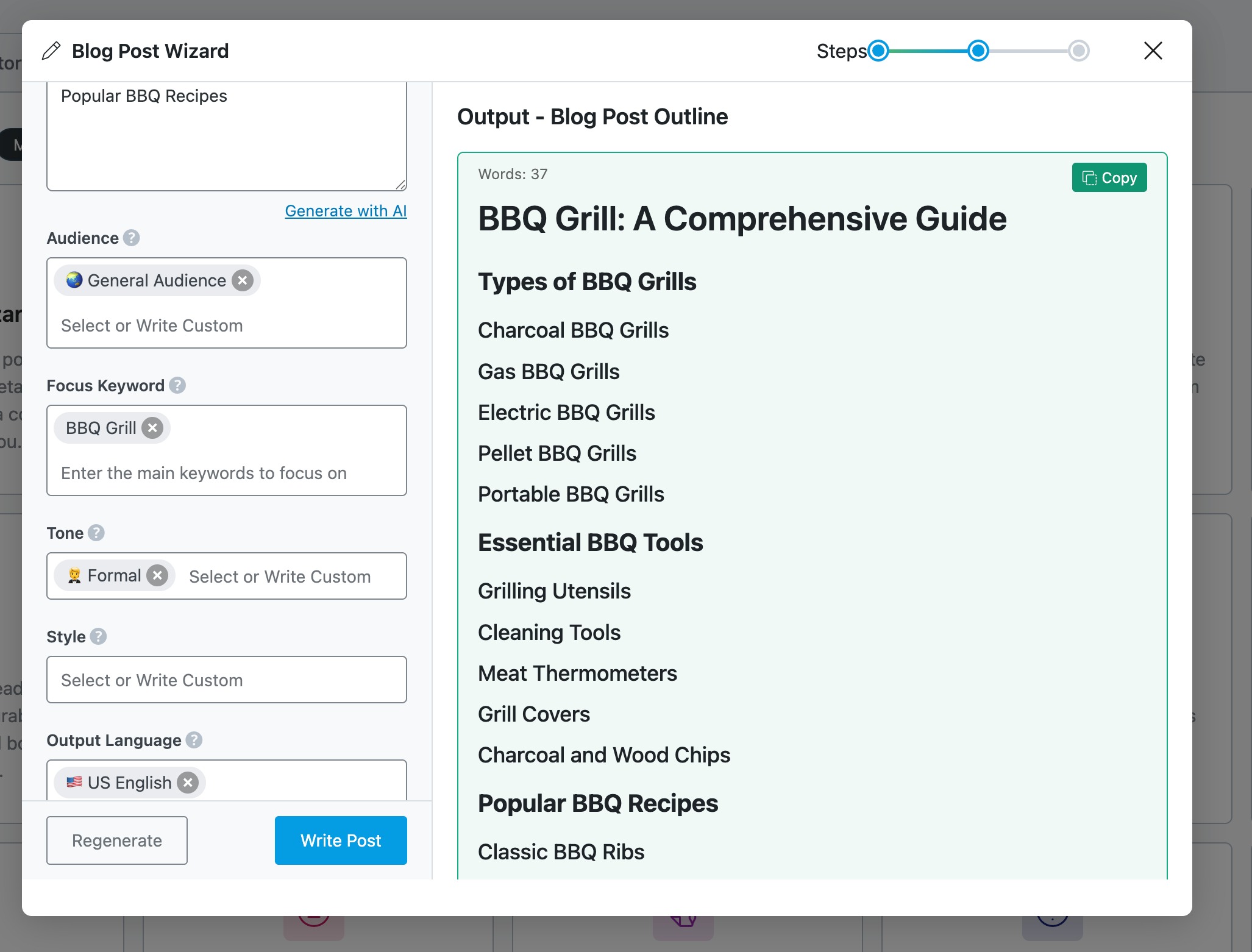
Within seconds, you’ll get a blog post outline. If you’re not satisfied with the result, you can tweak the inputs and regenerate it.
Click on Write Post, and the tool will generate a complete long-form post for you in no time.
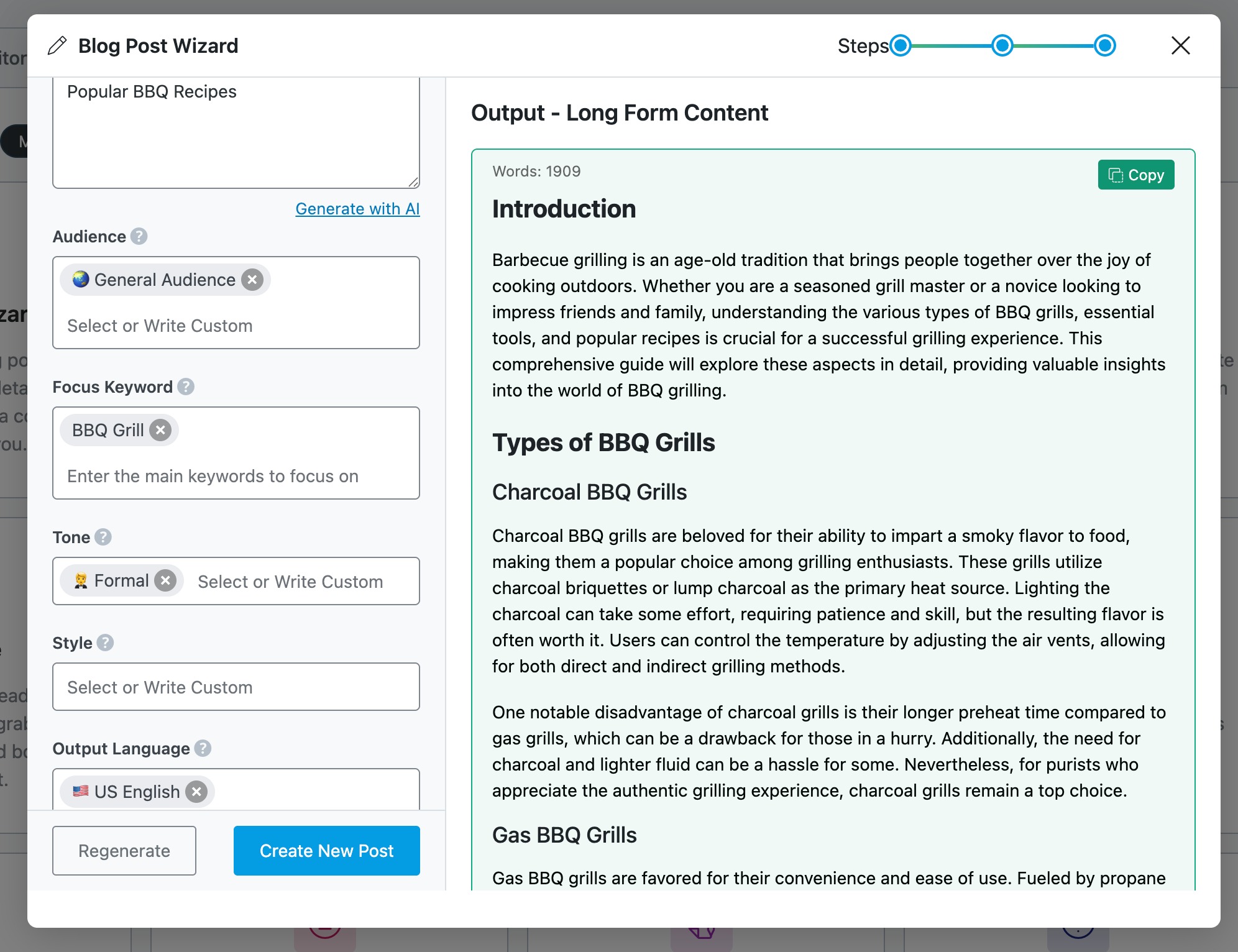
Additionally, use visuals such as images, videos, and infographics to complement your written content and enhance readability.
8 Optimize for On-Page SEO
On-page SEO refers to optimizing specific elements to improve rankings.
With every post you create, Rank Math provides strategic recommendations to help you optimize your content for maximum traffic.
By following these suggestions, your post becomes fully optimized from a content perspective, increasing its chances of ranking higher in search results.
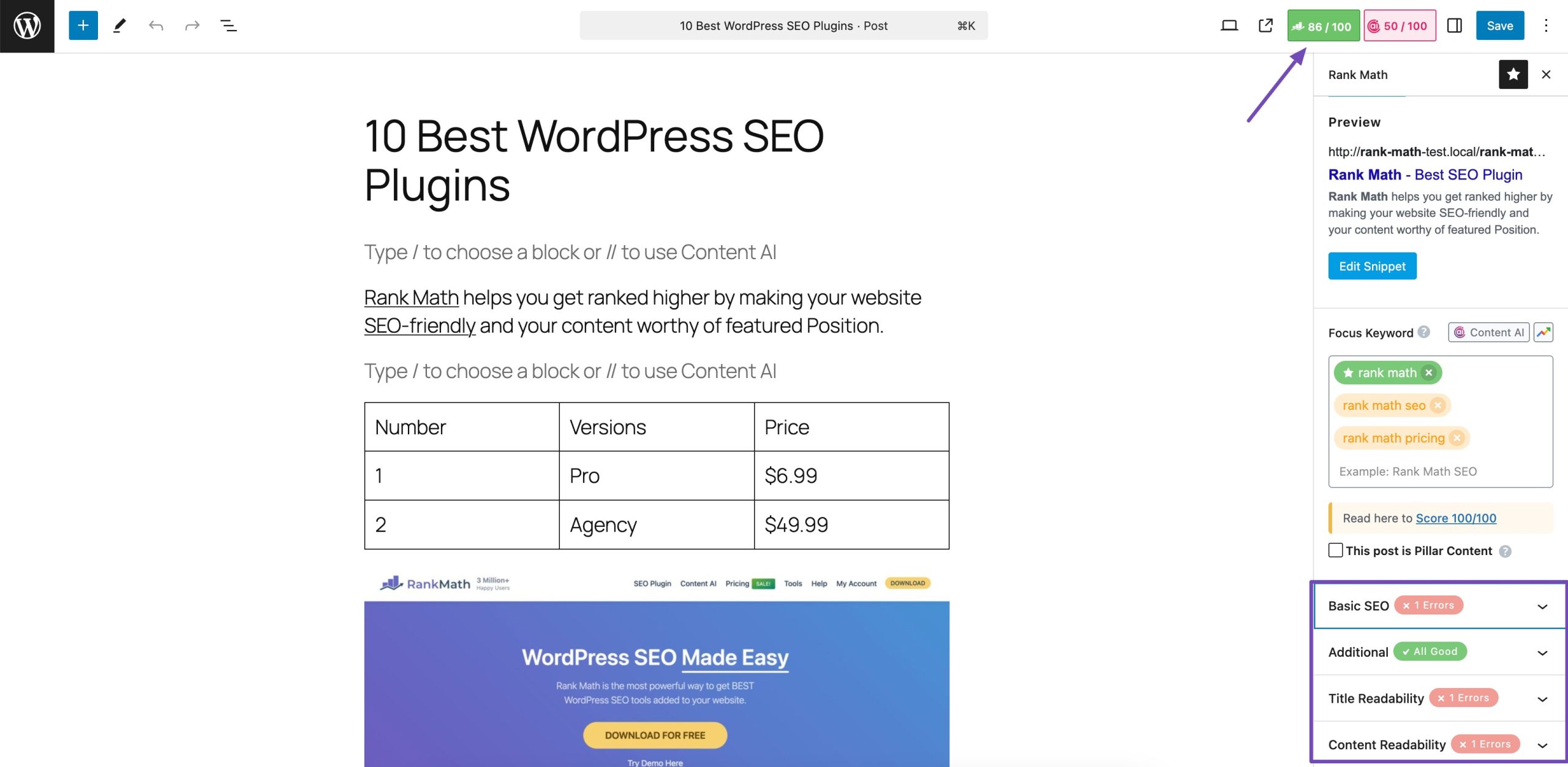
We’ve listed the best practices for on-page SEO.
- Keyword Placement: Place relevant keywords naturally in titles, headings, meta descriptions, and body content without overstuffing.
- Quality Content: Create engaging, informative content that adds value to your audience and ensures originality.
- Meta Tags: Create compelling meta titles and descriptions with keywords, keeping them concise and descriptive.
- URL Structure: Use clean, keyword-rich URLs that are easy to read and understand.
- Internal Links: Incorporate internal links to connect related pages and improve navigation.
- Image Optimization: Optimize images with descriptive filenames, alt text, and captions with relevant keywords.
For further details, refer to our dedicated tutorial on on-page SEO.
9 Enhance User Experience
Start by choosing a high-quality theme. A good theme should be mobile-friendly by default, offer plenty of customization options, be compatible with popular plugins, and most importantly, prioritize speed and performance. If you’re unsure where to start, we recommend a few themes that meet these criteria:
- GeneratePress
- Blocksy
- Astra
- Neve
- Kadence
Next, be mindful of the plugins you install. While there’s no strict limit, adding too many can slow down your site. Focus on essential features and avoid single-use plugins that serve only one purpose, such as handling redirects alone.

Instead, opt for multifunctional plugins that offer a range of features without compromising performance. Rank Math combines tools like 404 monitoring, analytics, instant indexing, local SEO, redirections, schema, and sitemaps—all in one lightweight package.
To improve SEO for a new website, carefully select your theme and plugins, and you’ll create a faster, more efficient, and enjoyable user experience.
Refer to our dedicated tutorial on speed optimization to enhance your site’s user experience.
10 Promote Your Website
Just because you’ve launched your website doesn’t guarantee that people will find it. You need to promote it actively.
Don’t hesitate to share your new website with your close circle. They’re likely to be supportive and can help spread the word.
Start gathering email addresses from interested visitors. This list will be invaluable for notifying subscribers whenever you publish new content.
If you’ve referenced or linked to other individuals or resources in your content, reach out to them. Find their contact information and send a polite email or direct message to inform them about your mention.
Join and actively participate in online communities relevant to your niche. Contribute valuable insights and share your content when appropriate (but avoid spamming) on platforms like Reddit, Slack, or Discord.
11 Track Your Performance
As a Rank Math PRO user, you can track between 500 to 1,000 keywords, depending on your plan. To access this feature, navigate to Rank Math SEO → Analytics, then click on the Rank Tracker tab.

If you haven’t used this tool before, click Auto Add Focus Keywords and enable auto-import. Choose the post types where your rankable content exists—typically blog posts, but you can include pages too. Rank Math will automatically add your main focus keyword (marked with a star) and, optionally, secondary keywords if you enable that option.
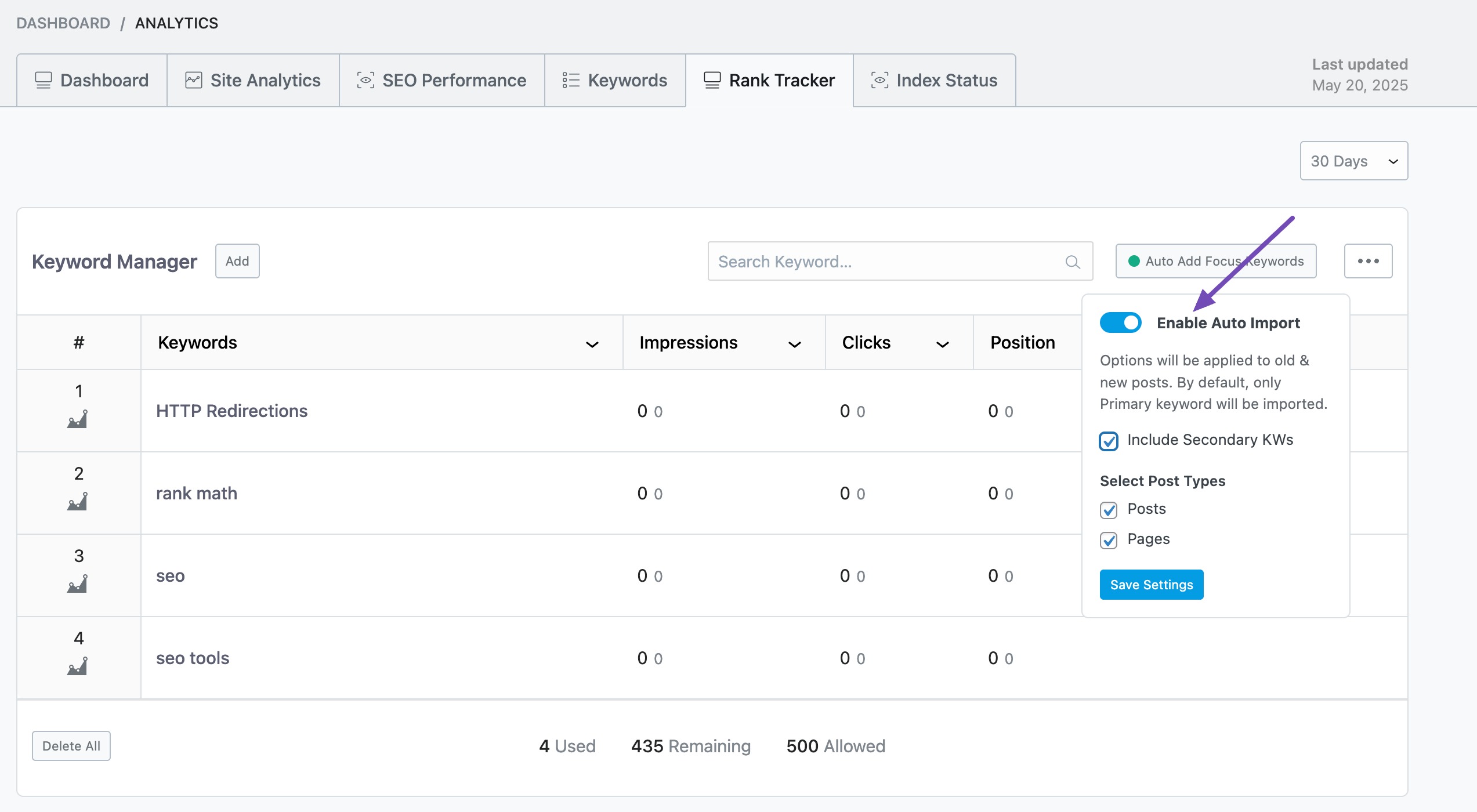
Once set up, expand the date range to the maximum. Prioritize updating posts that are over 12 months old for better chances of regaining traffic.
While Rank Math’s analytics are powerful, you can also use Google Search Console for additional insights and improve SEO for your website.
Conclusion
Launching a new website is just the beginning; mastering SEO is what helps it grow.
By focusing on core strategies like keyword research, on-page optimization, and creating valuable content, you set the foundation for higher search visibility and steady organic traffic.
Prioritize user experience, stay updated with SEO best practices, and continue delivering value, and your website will be well-positioned for long-term success.
If you like this post, let us know by Tweeting @rankmathseo. We’d love to hear your thoughts!
